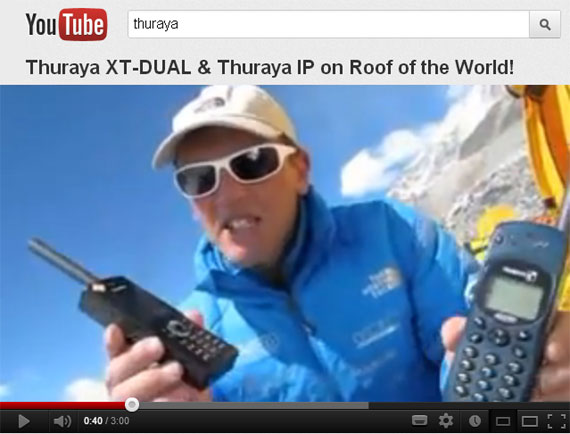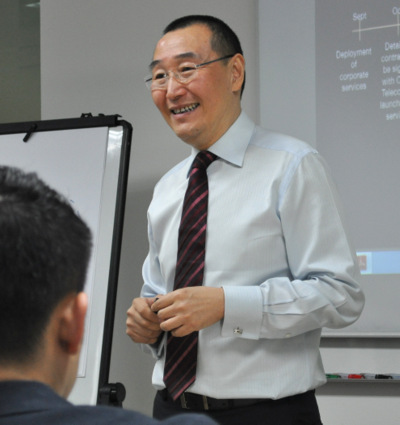
Click on video above as noted mountaineer Simone Moro demonstrates satphones Thuraya XT-DUAL and Thuraya IP on Mount Everest.
TWO IMPORTANT milestones will happen in the next 2 months for Armarda Group's transformation from being an IT consultancy provider into a mobile satellite services provider.
First is the launch by PRC state-owned telco China Telecom of its mobile satellite service with the help of Armarda’s 45%-owned associate company, China Mobile Satellite Communications Group (CMSCG).
"We are confident of launching mobile satellite services through China Telecom to 300,000 corporate users in the next 36 months," said Armarda executive director Terence Luk during a recent investor briefing that NextInsight attended.
Secondly, after shareholders of Singapore-listed Armarda approve the issue of 920 million shares (EGM is expected soon) for the acquisition of its 45% interest in CMSCG, its bottom line will reflect its share of profits from CMSCG.

In the meantime, it's tough going: Armarda last night announced that it would report a loss for 2Q of FY2013 ended 30 September 2012.
But things are brighter at CMSCG.
In September, it clinched two contracts to supply a total of 5,000 satellite mobile phones to China Telecom and China’s civil defense department.
”Initial profits from CMSCG look promising,” said Mr Luk.
Only three mobile service providers have satellite beams that cover China: Inmarsat (UK), Iridium (USA) and Thuraya (United Arab Emirates).
What's exciting for Armarda is that Thuraya is relying on CMSCG’s tie-up with China Telecom to supply the UAE satphone player's hardware and airtime to China’s huge market.
At the investor briefing, Mr Luk highlighted several markets that will need mobile satellite services.
Target Markets
Marine & Offshore Oil Drilling
China has about one million fishing vessels of which about 300,000 venture far out into the ocean where mobile satellite communications is needed.
But its telcos do not operate satellite networks. The two largest Chinese telcos (China Mobile and China Unicom) are not licensed to provide mobile satellite services.
Only China Telecom is, and CMSCG is its only partner for the provision of satellite beams.
Because of this market gap, about 30,000 Chinese phone users currently use other satellite providers such as Iridium and Inmarsat for their offshore needs.
Being the no.3 telco looking to enlarge its niche, China Telecom views mobile satellite communications as an important market.
Relief and Emergencies
When natural disasters strike, terrestrial communication networks such as GSM or CDMA are usually disrupted because of the damage to infrastructure on the earth.
Phone communication is vital for relief workers to assess the damage, and to coordinate relief operations.
Here’s where satellite communication networks come in. There is huge demand during emergencies. Some 1,500 satellite phones were rushed to the disaster epicenter during the Sichuan earthquake.
With the hard lessons from the Sichuan earthquake in 2008 and its death toll estimated to be as high as 50,000, the Chinese government is planning to have satellite phones located in specific areas for emergencies.
It's not just disasters -- The Thuraya module will also be useful for flood control, weather forecast and geology using satellite data.
Luxury retail
There’s even a high-end consumer market for mobile satellite phones.
In China, there is huge demand for the latest high-end mobile phones or other luxury goods in its emerging nouveau-riche culture that craves to flaunt one’s social status.
Armarda has engaged Korean satellite mobile phone manufacturers to develop dual-SIM smart phones for business users.
These phones automatically switch between normal and satellite modes, depending on the signal strength.
Prototypes of these dual-SIM phones and their accessories have been produced. Mass production will start in 6 to 12 months.
Defence
The military and civil defense sectors are also target markets as Thuraya’s integrated satellite communication service is rapidly deployable, employs the highest level of encryption, and meets exacting security standards.
CMSCG’s recent contract to supply 3,000 Thuraya satellite phones to the PRC Civil Defense Department is one example of its market potential.
Mr Luk expects more contracts from China’s Ministry of Defense, which has said it intends to equip its special armed police forces with satellite telecommunications equipment.
Related story: ARMARDA: Launching Satellite Phone Service Through China Telecom Next Year






